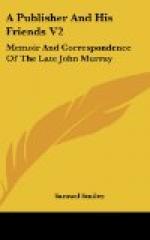CHAPTER XII
VARIOUS PUBLICATIONS—CHARLES MATURIN—S.T. COLERIDGE—LEIGH HUNT
Scott’s “poor Irish friend Maturin,” referred to in the previous chapter, was a young Irish clergyman, who was under the necessity of depending upon his brains and pen for the maintenance of his family. Charles Maturin, after completing his course of education at Trinity College, married Miss Harriet Kinsburg. His family grew, but not his income. He took orders, and obtained the curacy of St. Peter’s Church, Dublin, but owing to his father’s affairs having become embarrassed, he was compelled to open a boarding-school, with the view of assisting the family. Unfortunately, he became bound for a friend, who deceived him, and eventually he was obliged to sacrifice his interest in the school. Being thus driven to extremities, he tried to live by literature, and produced “The Fatal Revenge; or, the Family of Montorio,” the first of a series of romances, in which he outdid Mrs. Radcliffe and Monk Lewis. “The Fatal Revenge” was followed by “The Wild Irish Boy,” for which Colburn gave him L80, and “The Milesian Chief,” all full of horrors and misty grandeur. These works did not bring him in much money; but, in 1815, he determined to win the height of dramatic fame in his “Bertram; or, the Castle of St. Aldebrand,” a tragedy. He submitted the drama to Walter Scott, as from an “obscure Irishman,” telling him of his sufferings as an author and the father of a family, and imploring his kind opinion. Scott replied in the most friendly manner, gave him much good advice, spoke of the work as “grand and powerful, the characters being sketched with masterly enthusiasm”; and, what was practically better, sent him L50 as a token of his esteem and sympathy, and as a temporary stop-gap until better times came round. He moreover called the attention of Lord Byron, then on the Committee of Management of Drury Lane Theatre, to the play, and his Lordship strongly recommended a performance of it. Thanks to the splendid acting of Kean, it succeeded, and Maturin realized about L1,000.
“Bertram” was published by Murray, a circumstance which brought him into frequent communication with the unfortunate Maturin. The latter offered more plays, more novels, and many articles for the Quarterly. With reference to one of his articles—a review of Sheil’s “Apostate” —Gifford said, “A more potatoe-headed arrangement, or rather derangement, I have never seen. I have endeavoured to bring some order out of the chaos. There is a sort of wild eloquence in it that makes it worth preserving.”
Maturin continued to press his literary work on Murray, who however, though he relieved him by the gift of several large sums of money, declined all further offers of publication save the tragedy of “Manuel.”
John Murray to Lord Byron.
March 15, 1817.




